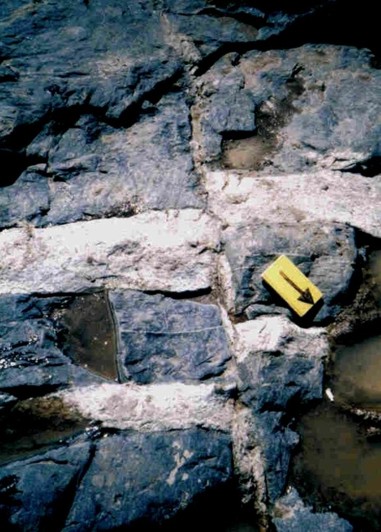


M.Sc. Research



![]()
The Structural Geology, Kinematics, and Timing of Deformation
at the Superior Craton Margin, Gull Rapids, Manitoba
The Gull Rapids area, Manitoba, lies on the Superior craton margin and forms part of the
Superior Boundary Zone, a major collisional zone between the Archean Superior craton and
the adjacent Paleoproterozoic Trans-Hudson Orogen.


There are two main rock assemblages at Gull Rapids:
1) orthogneisses (of possible Split Lake Block origin) and
2) supracrustal rocks (metavolcanic and metasedimentary)
Late, crosscutting felsic and mafic intrusive bodies (mostly dykes and sills) are used to
constrain the relative and absolute timing of deformation and metamorphism.
The Gull Rapids area records a complex tectonic history. The area experienced four generations of
Neoarchean ductile and brittle deformation (G1 – G4) and one of Paleoproterozoic ductile-brittle deformation (G5).
1) G1 deformation produced the main foliation in the map area, as well as local isoclinal folding which may
be related to an early shearing event. M1a prograde mid-amphibolite facies metamorphism is
contemporaneous with the early stages of G1.
Typical photo of terrain at Gull Rapids S1 foliation in metasediments,
with S1-parallel granitoid injection
2) Widespread, tight to isoclinal sheath folding during G2 was recorded in the supracrustal assemblage,
and is the result of southwest-side-up, dextral shearing during the early shearing event.
A ca. 2.68 Ga widespread phase of granitoid intrusion was emplaced late-G1 to early-G2,
and is rich in metamorphic minerals that record conditions of M1b upper-amphibolite facies peak
metamorphism. M1b metamorphism, late-G1 to early-G2 deformation, and intrusion of this felsic
phase are contemporaneous. M2 retrograde metamorphism to mid-amphibolite facies was
recorded sometime after M1b.
F2 folds in amphibolite
Late-G1 to early-G2 granitoid injection (injection is subparallel to S1, then is folded by F2).
Age of this granitoid constrains age of late-G1 to early-G2 deformation.
Age of rock is ca. 2.68 Ga

Injection in boudin neck; injection is therefore syn-boudinage (boudinage is late-G1 to early-G2).
Age of rock is ca. 2.68 Ga
3) G1 and G2 structures were re-folded during G3, which was then followed by
4) G4 southwest-side-up, dextral and sinistral shearing,
contemporaneous with late pegmatite intrusion at ca. 2.61 Ga.
G4-G5 brittle shear zone
Granitoid sills, cut by late-phase pegmatite dyke, cut by mafic dyke.
G5 shearing post-dates mafic dyke emplacement, therefore shearing
related to pegmatite dyke emplacement is G4

Pegmatite dyke is sheared, yet material flows into and along the shear plane,
therefore pegmatite emplacement is syn-shearing. This shearing is G4.
Age of rock is ca. 2.61 Ga
5) This was followed by mafic dyke emplacement at ca. 2.10 Ga, and then by G5 sinistral
and dextral shearing and M3 greenschist facies metamorphism or hydrothermal alteration at ca. 1.80 Ga.
Deformation and metamorphism at Gull Rapids post-dates emplacement and deposition of gneissic
and supracrustal rocks, respectively. This deformation and metamorphism, except for G5 and M3, is
Neoarchean (ca. 2.68–2.61 Ga), and represents a significant movement of crustal blocks: km-scale shearing
of the supracrustal assemblage and consequent uplift of the Split Lake Block. Late deformation and
metamorphism (G5, M3) may be related to the Paleoproterozoic Trans-Hudson orogeny. The Neoarchean and
Paleoproterozoic zircon populations in the geochronological data suggest that the Gull Rapids area largely
experienced Neoarchean deformation and metamorphism with a weak Paleoproterozoic overprint. All of the
evidence presented above suggests that the Gull Rapids area lies in a part of the Superior Boundary Zone,
yet does not lie at the exact margin of the Superior craton, and therefore does not mark the
Archean-Proterozoic boundary proper in northeastern Manitoba.